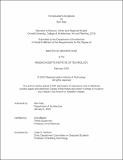Homebuilder’s Songbook
Author(s)
May, Samuel
DownloadThesis PDF (30.32Mb)
Advisor
Miljački, Ana
Terms of use
Metadata
Show full item recordAbstract
This thesis considers the potentials of cultural practices in transforming single-family housing in the present-day United States through a series of speculative designs. An archival assemblage documenting historical modifications to houses, along with music and other cultural artifacts, forms the working material for these speculations.
In examining the role architects have played in imaging the single-family house, this thesis first explores a paper trail of pattern books, catalogs, and manuals. This lineage of disseminated media shows how designers have continually recast the house in response to larger social and technological changes through largely consistent representational strategies.
A parallel examination of archives like the Historic American Building Survey demonstrates how communities have continually leveraged accessible building methods to make alterations to their own houses, developing new modes of building and dwelling in what Bell Hooks described as “Architecture as cultural practice.”
In the past century, cultures of expertise have driven decisions about housing further and further from those impacted, limiting the cultural reconstruction of housing by its inhabitants. Left unchanged, inherited neighborhoods of single-family dwellings fail to meet the pluralistic needs of the communities left with them, and those excluded from them.
Questioning the architect’s historic role in single-family housing, this thesis moves away from the prescriptive format of the catalog and towards a cultural anthology. Architecture can learn from methods of music production and scholarship for their potential to celebrate the subjectivity of voice, acknowledge co-authorship, and reflect cultural diversity. Where the catalog offers the available options, the songbook provides material with which to play. Through design and collaboration with active musicians and songwriters, this thesis speculates as to how architects, as participants and facilitators, might enliven homes with song.
Date issued
2023-02Department
Massachusetts Institute of Technology. Department of ArchitecturePublisher
Massachusetts Institute of Technology